+Search query
-Structure paper
| Title | Uptake mechanism of iron-phytosiderophore from the soil based on the structure of yellow stripe transporter. |
|---|---|
| Journal, issue, pages | Nat Commun, Vol. 13, Issue 1, Page 7180, Year 2022 |
| Publish date | Nov 23, 2022 |
 Authors Authors | Atsushi Yamagata / Yoshiko Murata / Kosuke Namba / Tohru Terada / Shuya Fukai / Mikako Shirouzu /  |
| PubMed Abstract | Calcareous soils cover one-third of all land and cause severe growth defects in plants due to the poor water solubility of iron at high pH. Poaceae species use a unique chelation strategy, whereby ...Calcareous soils cover one-third of all land and cause severe growth defects in plants due to the poor water solubility of iron at high pH. Poaceae species use a unique chelation strategy, whereby plants secrete a high-affinity metal chelator, known as phytosiderophores (mugineic acids), and reabsorb the iron-phytosiderophore complex by the yellow stripe 1/yellow stripe 1-like (YS1/YSL) transporter for efficient uptake of iron from the soil. Here, we present three cryo-electron microscopy structures of barley YS1 (HvYS1) in the apo state, in complex with an iron-phytosiderophore complex, Fe(III)-deoxymugineic acid (Fe(III)-DMA), and in complex with the iron-bound synthetic DMA analog (Fe(III)-PDMA). The structures reveal a homodimeric assembly mediated through an anti-parallel β-sheet interaction with cholesterol hemisuccinate. Each protomer adopts an outward open conformation, and Fe(III)-DMA is bound near the extracellular space in the central cavity. Fe(III)-PDMA occupies the same binding site as Fe(III)-DMA, demonstrating that PDMA can function as a potent fertilizer in an essentially identical manner to DMA. Our results provide a structural framework for iron-phytosiderophore recognition and transport by YS1/YSL transporters, which will enable the rational design of new, high-potency fertilizers. |
 External links External links |  Nat Commun / Nat Commun /  PubMed:36424382 / PubMed:36424382 /  PubMed Central PubMed Central |
| Methods | EM (single particle) |
| Resolution | 2.7 - 2.9 Å |
| Structure data | EMDB-32765, PDB-7wsr: EMDB-32766, PDB-7wst: EMDB-32767, PDB-7wsu: |
| Chemicals |  ChemComp-Y01:  ChemComp-FE: 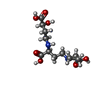 ChemComp-554: 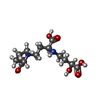 ChemComp-5ZS: |
| Source |
|
 Keywords Keywords | METAL TRANSPORT / iron-phytosiderophore transporter / deoxymugineic acid / proline 2'-deoxymugineic acid |
 Movie
Movie Controller
Controller Structure viewers
Structure viewers About Yorodumi Papers
About Yorodumi Papers




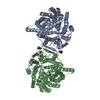

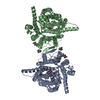

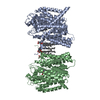
 Iron
Iron
